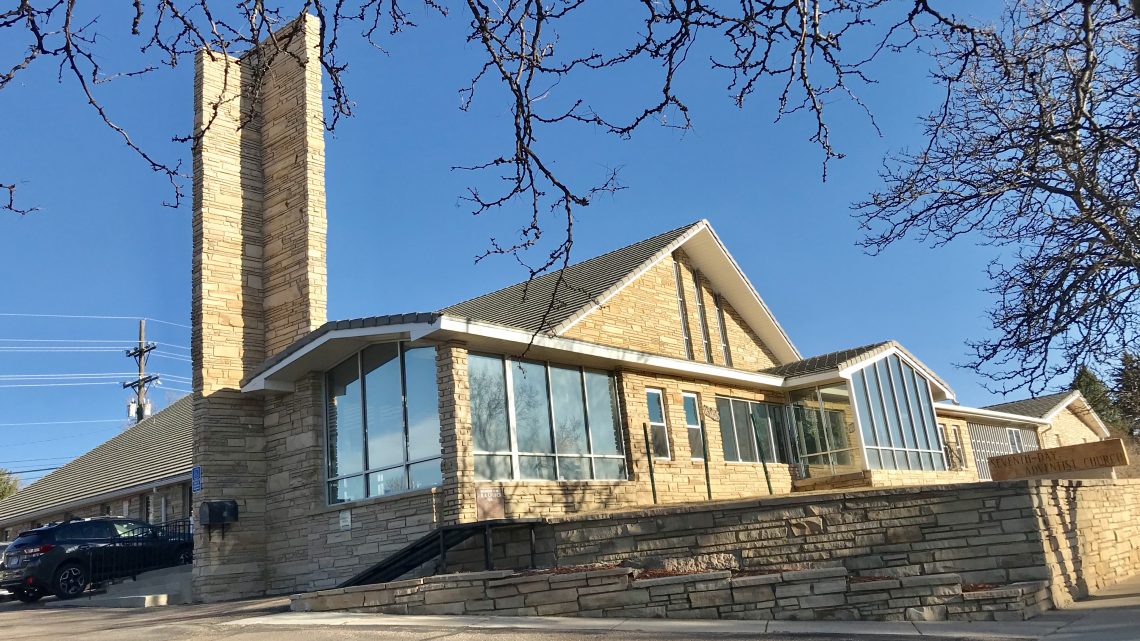A weathered stone plaque on the corner of Colorado Springs Central Church reveals that its beginnings date back to 1890. In those early days, James and Ellen White, among other Adventist pioneers visited the area. Church history lists Susan Bysong Shaw as the first Adventist in Colorado and a charter member. She is referred to as the first clerk and treasurer for the congregation. In the early 1860s she crossed the plains in a covered wagon and her contact with the Adventist faith was the result of reading Adventist literature and studying the Bible.
After settling in Colorado Springs, she started a Sabbath school in 1898. The group included members of Susan Shaw’s family, and that of her sister. Tuesday, August 26, 1890 is recorded as the organizing meeting of the church with six charter members present.
From the small nucleus of that first congregation, today’s church on Union Blvd is the third home to the congregation and was built in 1966. Now, the membership is just a little more than 600. Mike Maldonado who took over as their pastor nearly 10 years ago, says that participation fluctuates each Sabbath. The sanctuary is spacious and on many a Sabbath, it bursts its proverbial seams as it hosts a variety of activities. “Our lowest is 250 and our highest is 350. At a recent Sabbath in March, we had 350 in church. On International Sabbath, it goes to 450. Average is 300 realistically,” he adds.
When Pastor Mike first got to Colorado Springs the “church was very unhealthy,” he explains. It had gone through quite a few years of declining health. “When I arrived, the morale was very low and attendance was very low. There was a lack of trust and people weren’t doing stuff together. My wife and I took the approach that, what the church needed more than anything else was tender love and care,” he comments. They started establishing relationships, doing fellowship meals and creating social activities. Little by little, people began to trust each other, to get reacquainted with one another. Reestablishing community that had been lost was a key to today’s health in the church.
Creating this safe place for people to come was really important to Pastor Mike. “In fact, that’s our vision statement — to create a safe environment for seekers and disciples, a place to grow in their relationship with Christ,” he explains.
Looking over the congregation, one notices its diversity.
Maldonado believes that many churches sink into a pattern where they just fit into a mold. In his words, “When we arrived, our church was basically a white, Anglo-Saxon, middle-aged church. Some of that was by design, and some by accident. My wife and I are both very international people. We just made the church a welcome place for all ethnicities. Instead of sending different people to the Black church, the Spanish church, or the Korean church, we said, ‘We want you here as part of our family.’ So, the church began to grow in terms of its cosmopolitan makeup.”
They instituted an International Sabbath, which is their largest service of the year. The whole service is done in different languages. People dress up in their native dress, and they celebrate the diversity that exists. Now the church is extremely diverse.
The local leaders also made the decision not to target the young or the old. Instead, they experimented to see if all age groups could live together peacefully. With at least 40 percent of the congregation made up of young adults and youth, they “really have been intentional about making it an all-inclusive church rather than exclusive,” Maldonado says.
The church is known for its consistent growth. Their philosophy of evangelism is connection – connecting with the people at every possible event. Sabbath is an evangelistic outreach with the pastor and the elders being very intentional about going through the hallways, the pews, the classrooms, connecting with people who are visiting. Community interaction, partnership with service organizations, feeding the poor and homeless also brings new people to the church.
Marcia Armstead is the pastor’s associate. She gets the names of those who visit their programs, collects their pictures and email addresses. And they follow up immediately, the next day, by inviting them to different programs.
If Colorado Springs Central were to disappear overnight, they would be missed, Maldonado believes. The church family itself would miss what they see as a vital part of their lives. There are many ways they are reaching out to the community through service. If we weren’t here, there would be a big empty spot in the community.
If we were to describe a healthy church, we could claim Colorado Springs Central as a good example, say Rocky Mountain Conference leaders. It’s the community, the fellowship they have, as well as the empowering of the laity that makes them a healthy congregation. Lay leaders are put in charge and it is hands off for the ministerial team. They just run with it.
“That is really what has grown the church. Just trusting my leaders without micromanaging and without having to dictate,” Mike Maldonado concludes with a broad smile on his face.









